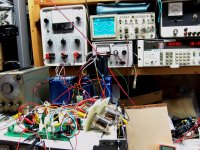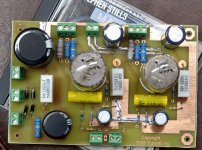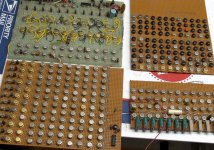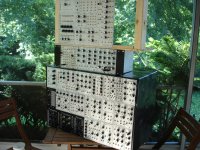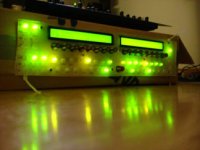direct copy of your work without your consent is not right,
Same schematic, same components values, different PC board layout. I created that design by connecting a 6LR8 compactron into a SSE board with a million clip leads. You can't make an amp work like that, right? I laid out a PC board, played with it for a few days and forgot about it. A few weeks later someone told me about a similar design on another forum.
To me it isn't much different than all the Fender and Marshall guitar amp clones out there. I think it was a good thing that it happened then, to a circuit that I wasn't sure about economically. That was a reminder to keep quiet about something until I am ready to sell boards.
is it going to be very complex?
There isn't an "it". There are about 6 years worth of circuit designs, simulations, and PC board layouts.
About 6 years ago my mother in law got cancer and was told she had 6 months to live. She enrolled in a "human experiment" at the University of Pittsburgh which was about 70 miles away from her home. Sherri spent more and more of her time up north with her mom driving her to Pittsburgh multiple times a week for treatment. The "experiments" gave her 4 more useful years during which Sherri was gone a lot and I was either working 60 hour weeks, or flying to Pittsburgh. I spent a lot of time, on the plane, in the UPMC waiting rooms, or in the back seat of her mother's car. During that time my laptop followed me around until it died, and Sherri's mom bought me a new one!
Sherri's mom passed away about 2 years ago, leaving us a house in West Virginia. I have known for a few years that I was way past my expiration date in my job at Motorola. Like, who works at the same place for 41 years, all my friends have been laid off, so we have been planning for the day my job runs out and we leave Florida for the last time. That day is one week from today, unless we decide to take a "Florida vacation" on the way out of here!
We will move into the house that Sherri's mom left us, but we are planning to have the house we really want built for us on an acre of land out in the country. It will have a full basement with room for me to build a good sized lab with room for a recording studio and listening room. The house won't be move in ready for about a year, then we can begin to move in. After we are in and settled, then I can start on my lab.
For 6 years I have "designed" various tube circuits, microprocessor circuits, music synthesizer circuits, guitar signal processing circuits, music controllers, and written a few dozen PIC programs to run some of the musical toys. I have used the term "designed" rather loosely. Some of these designs are nothing more than a paper (or Eagle) schematic, some are just a wild idea committed to a PC board, others are just LT Spice simulations, but a few have been built and tested.
I briefly mentioned an amp with 13GB5's that makes 100 WPC. That is a working breadboard with about 4 hours of tinker time on it. There will be 3 unique boards in the amp. The driver board is the same board I designed with forum member chrish in the 6L6GC AB2 thread. The output board is something new and unique, and still in flux. Multiple versions from 35 watts to 400 watts exist in the computer. The power supply is still untested.
Many people know the infatuation I had with Pete Millett's engineers amp. At one time I had 3 of them operational. I transformed Pete's mild mannered 18 WPC amp into a 125 WPC design that anyone can copy, all the info is in that thread and at least a dozen 125 WPC versions have been built that I know about. I also used that board, Pete's driver board, and a few of my own boards to explore several new concepts in tube amps, and rehash a few old designs. Some of these should continue to evolve into amp designs as time becomes available.
Many also know that I have played guitar since starting guitar lessons at age 8. I never got really good at it, and realized I would never be a rock star when I saw Jimi in concert in 1967. I also began tinkering with amps around the same time, and in 1960 any amp that I could get, had tubes! I have made guitar amps on and off ever since.
In 1970 I saw ELP and became infatuated with the Moog Synthesizer. All synthesizers in 1970 were analog, voltage controlled. I got an idea for a completely digital synthesizer and in 1971 I started building it. It took about a year to make sound, after all I was using free IC's obtained from the dumpster behind the Coulter Diagnostics (blood counters) factory. They were all RTL. This was before CMOS was invented! Yes, there are about 400 chips on those boards, all hand soldered PTP style. Yes, I still have them after 40+ years. I have started work on a new synthesizer, and several other music generation related devices. No tubes in these projects with the exception of a vacuum tube VCA / Envelope Follower and compressor. This is not just another copy of one of the $$$$ classics. There are plenty of these out there already.
There are 3 working guitar amps that evolved from work started in the Hundred Buck Amp Challenge thread. More will be created from those designs. The schematic for one was posted in that thread, and another was described pretty well. Both have gone through some changes since that work ended.
There is a new movement in the generation of music that seems to appeal to the younger generation. There are music "controllers" that can be used to trigger pre canned musical phrases. They vary from simple button controllers to complex custom devices. I have designed one of my own, and built one into an electric guitar. This allows one to generate a beat, a bass line, and play guitar along with it all. It seems that I am not the only person with this idea.....Controllerism.com
Attachments
George, before I got bored with it (all my friends in to music production moved away) I was very in to building electronic instruments, synths, drum machines, sequencers, etc. I've been thinking about getting back to it.. I have a bunch of analog synth module PCB's I made and never populated...
Here's my modular, and old version of my sequencer, in a cardboard box .
.
The little paia synth modules, black ones on the bottom left, were my introduction to electronics (besides playing w/ led's and such). From there I got other peoples bare PCB's and finally started designing my own lfo's and filters and things..
I've been reading up on tube analog synths, and am thinking about building one... But they're difficult to control (if you want standard tuning and keyboard control).
(Sorry for the OT)
Here's my modular, and old version of my sequencer, in a cardboard box
The little paia synth modules, black ones on the bottom left, were my introduction to electronics (besides playing w/ led's and such). From there I got other peoples bare PCB's and finally started designing my own lfo's and filters and things..
I've been reading up on tube analog synths, and am thinking about building one... But they're difficult to control (if you want standard tuning and keyboard control).
(Sorry for the OT)
Attachments
Last edited:
George, I know it is probably not the right forum area to ask, but will the mail order side of Tubelab still be operational during the move or is it going to take a hiatus?
Good luck with the move.
Gary (another one who got involved with building a big analog synth after seeing ELP)
Good luck with the move.
Gary (another one who got involved with building a big analog synth after seeing ELP)
but will the mail order side of Tubelab still be operational during the move or is it going to take a hiatus?
All board shipments will work as normal with only a maximum of a three day delay if an order comes in as I pull out of Fort Lauderdale. In that case it won't ship until I get to WV. With a loaded trailer attached to my 4 cylinder Honda, on the 4th of July weekend.....maybe 4 days this time!
I have been going back and forth between the two locations for a dozen years or more and I have boards stashed in both places. I have shipped from West Virginia whenever I am there, and nobody has noticed yet. Actually the little 2 man post office seems to be far more efficient that the larger operation here in Florida. I can't count the number of times a 2 day Priority Mail envelope spends 10 days stuck in Miami (or Los Angeles). Those two "mail sorting centers" are actually black holes where mail checks in, and doesn't check out.
The little paia synth modules
I bought the original Paia 2700 Synthesizer kit in 1972. I think I ordered it in 1971 and it took about a year to get. Cheap too, maybe $150. No keyboard, just wires and buttons. I ditched that and rigged in a keyboard liberated from a dead organ. I had a Gnome, too. Once I got the job at Motorola with a steady $3.57 per hour paycheck, I ditched them all and bought a whiteface Odyssey that was "sick". I replaced the noisy CA3080's and it rocked for over 10 years and became the center of a bench full of VCO's, VCF's top octave generators with divider chains and even a home made Leslie. It's all gone now and all my synth's are made out of ones and zeros that live inside of this Windows box.
That will change, but my new "modular" will still have a core I5 motherboard AND some VCO's, VCF's an ADSR or two, a couple of VCDO's (I made them with PIC chips and DDS chips) an arbitrary waveform generator and a few other tricks. It will resemble an Odessey in form factor, but house Eurorack modules.
I've been reading up on tube analog synths, and am thinking about building one...
I have been investigating that as well. A true 1V/OCT scale is hard to do with an all tube design, and keep the tracking and drift issues to a minimum. I decided that the VCA would be the easiest circuit to tackle first since errors only affect amplitude, not pitch. It is also a path I need to conquer in order to design a new vacuum tube audio compressor. A compressor is a VCA, a controller, and an envelope follower. There were several "reference standard" tube compressors used in the broadcast industry that have become cult classics commanding stupid price tags today. ALL of these used the 6386 tube which has become rather hard to get....Even Sovtek knockoffs cost over $100 each!!!!! I have about a dozen from the 1950's and started characterizing their control characteristics about 2 years ago. You get about 50 db of gain control from a CV that goes from -50 volts to zero. I am still looking for a cheap TV tube that can do the same gain range on a 5 volt CV swing.
Reality probably dictates that there will be some silicon, and maybe even some digital assistance in whatever "tube" synthesizer modules I design. You can find high voltage opamps that can scale a 1V/OCT CV into whatever needed to control a tube VCO, but tracking is still a problem, not to mention thermal drift.
I have been experimenting with a PIC microcontroller and a 16 bit D/A converter. Use the A/D inside the PIC to read the CV, then a lookup table applies the needed correction and sends the data to the D/A. The lookup table can be different for each VCO, and one PIC chip can handle a dozen SPI or I2C D/A's, each with their own VCO, AND feed a hand full of DDS chips.
Maybe it's time to start a modular synth thread and move all of this stuff to it (Instruments & amps, Tubes, or Tubelab forum????). It will be all just talk for several months or so, but some of my modular IS actually built and it's small enough to set up on a table, so I should be able to tinker with it in the temporary house.
Maybe it's time to start a modular synth thread and move all of this stuff to it
OK
http://www.diyaudio.com/forums/instruments-amps/258400-modular-synthesizer-tubes.html
Recall that the TV vertical output amplifier needs linear valves, nobody likes to see a distorted image.
Today we see the 6SN7 in hi-end audio, at a time was very common to see on TV (so the TV had vertical adjustment in the front)
My brother died and left me his TV books ( 100's). He was local TV repair man and I suspect a genius. I even stayed in his bedroom to read them all surrounded by his boxes of parts including OC series transistors. Each returned to it's place when finished.
I suddenly realized my Audio tubes started life in TV. 7199 was adapted to have a larger market by adding a screen. PCL86 often was in the sound stage as it was economical to use it.
My brother showed how speech was better if feedback was removed from the P/E/U CL86 ( 82/84) and the pentode made triode. When I asked how come he said " they read how to do it in a book and were TV engineers".
He repaired TV's for the old people of Chipping Norton. Every TV that ever existed received a reliability upgrade. He loved the Philips G8 and recognized instantly how EAR 509 amp work. He loved to say how the BU transistor was better than the Sony that cost 5 times more and gave trouble.
Look up Simon Pearson at the National valve museum for his TV tubes. He died Christmas day which suited his style. Flu !
Popilin. My brother showed me how to do grey scale of a Sony TV . When I said shadows go from green to blue he said I had learnt a valuable Audio lesson. That is the linearity of zero loop feedback SE class A.
The more interesting thing to say is bipolar TV drive transistors might have a life in valve audio. The designers were seeking identical solutions. BF720 and 721 look suspiciously like gun drivers. MPSA 42 92 look TV types.
Simon thought Sony over rated . Little metal strips stuck on the tube to get it do BBC test card F. He insisted they used NTSC ( Never Twice the Same Colour) red for PAL. They did this as it was cheaper and gave a different look. Personally I disliked it. His favoutie ITT KB. The valve version having typical 17 years tube life and transistor 11 year for the slow heating PSU reason. Same tube. Another was Decca Bradford.
The more interesting thing to say is bipolar TV drive transistors might have a life in valve audio. The designers were seeking identical solutions. BF720 and 721 look suspiciously like gun drivers. MPSA 42 92 look TV types.
Simon thought Sony over rated . Little metal strips stuck on the tube to get it do BBC test card F. He insisted they used NTSC ( Never Twice the Same Colour) red for PAL. They did this as it was cheaper and gave a different look. Personally I disliked it. His favoutie ITT KB. The valve version having typical 17 years tube life and transistor 11 year for the slow heating PSU reason. Same tube. Another was Decca Bradford.
Unfortunately not, however the other television rectifiers like like the py 81 82 88 and the monstrously powerful PY500 are in plenty-full supply.
The 88 can be run of a simple rectified 24vac transformer. You can substitute it in designs that normally would call for a tube like the 5AR4
The 88 can be run of a simple rectified 24vac transformer. You can substitute it in designs that normally would call for a tube like the 5AR4
It is said they make cheap X ray source for DIY X rays (yikes). Might give some a test at higher power and 500 V to see where it goes. No longer cheap.
EF 184 my favoutite.
A try story. When I was about 20 which is almost 40 years now a chap was soldering up a TVA 80 KT88 amp. He wasn't very impressed. He said to me he could design any amp to sound good. His next plan was to use PL509 as it was the most unsuitable device he could think of. It would be a test of his skills and his ability to judge the lack of knowledge of the press. This amp became the EAR509. His sister only lives 5 km from me.funny small world. My dream at the time was make it class D and send it for review without saying a word.
EF 184 my favoutite.
A try story. When I was about 20 which is almost 40 years now a chap was soldering up a TVA 80 KT88 amp. He wasn't very impressed. He said to me he could design any amp to sound good. His next plan was to use PL509 as it was the most unsuitable device he could think of. It would be a test of his skills and his ability to judge the lack of knowledge of the press. This amp became the EAR509. His sister only lives 5 km from me.funny small world. My dream at the time was make it class D and send it for review without saying a word.
Fenris, thanks for the offer, but due to the load in the trailer and the storm to the east, we took I-75 north rather than I-95 to I-26 to I-77. We also closed on the house early and are already in Ohio. We are out of Florida for good.....unless I decide to go there for vacation someday.
Well your closer to the Dayton Hamvention next year. Keep us up on the building progress there in WV . RegardsFenris, thanks for the offer, but due to the load in the trailer and the storm to the east, we took I-75 north rather than I-95 to I-26 to I-77. We also closed on the house early and are already in Ohio. We are out of Florida for good.....unless I decide to go there for vacation someday.

Why would anyone in their right mind want to do that?...or just get from WV, you are always welcome.
Well the Ex-wife did she moved to Dayton Ohio explain that . Then again she is an EX.Why would anyone in their right mind want to do that?

> > I know Lynn Olson is also a big proponent of dampers; I'd like to think he got the idea from me, rather than the other way around.
(Actually, it's probably more like an Alexander Graham Bell/Elisha Gray thing). << Quote
I've known about this for years an came to the same conclusion myself. I did the same with other tubes like the 807 - while everyone was buying 6L6 and KT66 I bought a swag of original sweet sounding tubes that won the 2nd world war and was built off the 6L6. Anything with a top cap used by the Military is far better than no top cap used in domestic applications.
Again the same with 6CM5's and a host of other frame grid triodes.
I've also even seen a 1S2 EHT rectifier used in a crystal set as the main detector!
It would handle lightning strikes better than any germanium diode and works quite well too.
The only issue I have with damper diodes is - they're technically pulse rated tubes and hence have a limited plate dissipation - but in saying that - they are very good for bench power supplies and HV rectifier work at low currents. Basically I love them for these sorts of applications!
I have much the same thoughts on this. I got VERY tired of feeding a Citation II with quality 6550s. While I was burning up the last of the good ones, bought a boatload of 1625 tubes. I have read much the same about 1625's ss 807's (the tube that won WW II). I'm glad I bought them when I did, as they are getting scarce.
Sold the HK, had a pair of quad monos built with a pair of 12SN7s for the front end(and a MOSFET regulator), and have not looked back. The 1625 amps actually sound better than the HK.
Now, speaking of TV tubes, had a preamp built based on Thomas Meyer's design. It sports a pair of 6AH4 line level tubes (transformer coupled), and a pair of 6DE4 damper tubes. Outstanding sound, and a great match for the 1625 amps.
Last edited:
I think I read 807 offered half power at 120 MHz? If so it might offer local FM radio or band 1 TV in UK. TT21 (CV8286) was two young lads asking the ladies who made KT88 to make a few with 807 style caps as radio transmitter valves. They told their boss who put them into production that week. The girls went dancing with the lads as a reward at the Hammersmith Palais de dance. LS50/Gu50/Fu50 I suspect was a TV tube in the same way as 807?
- Home
- Amplifiers
- Tubes / Valves
- Those Magnificent Television Tubes
